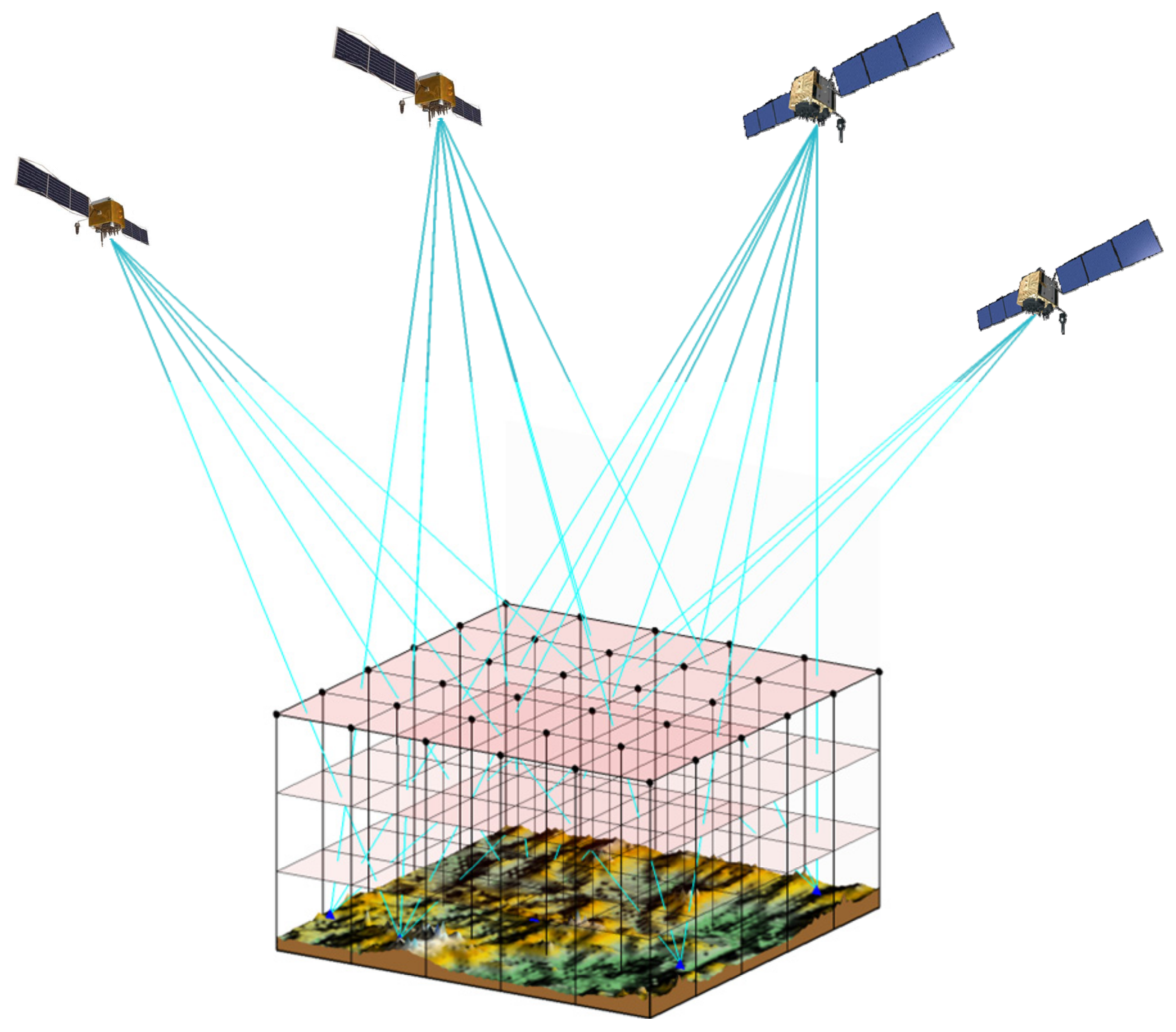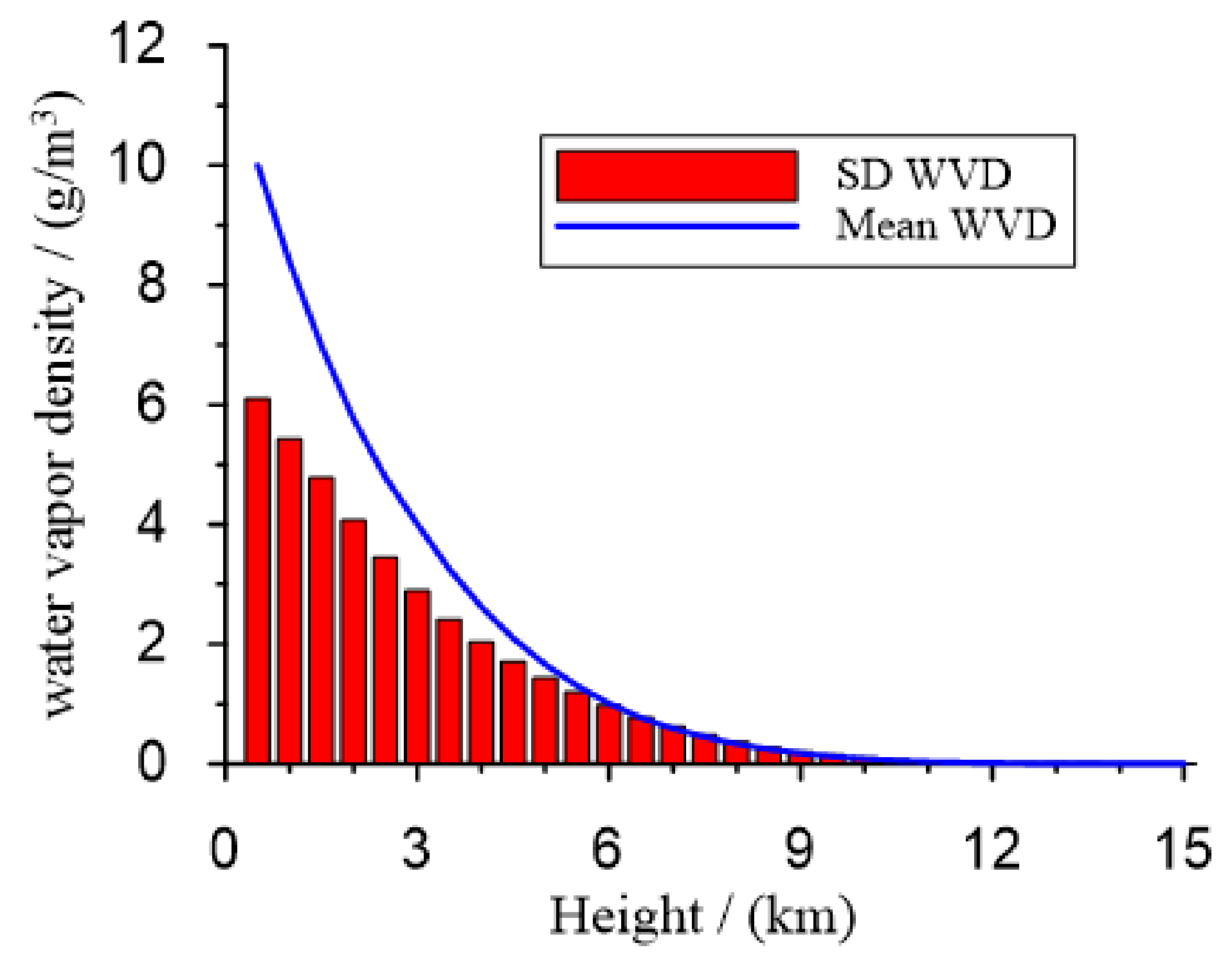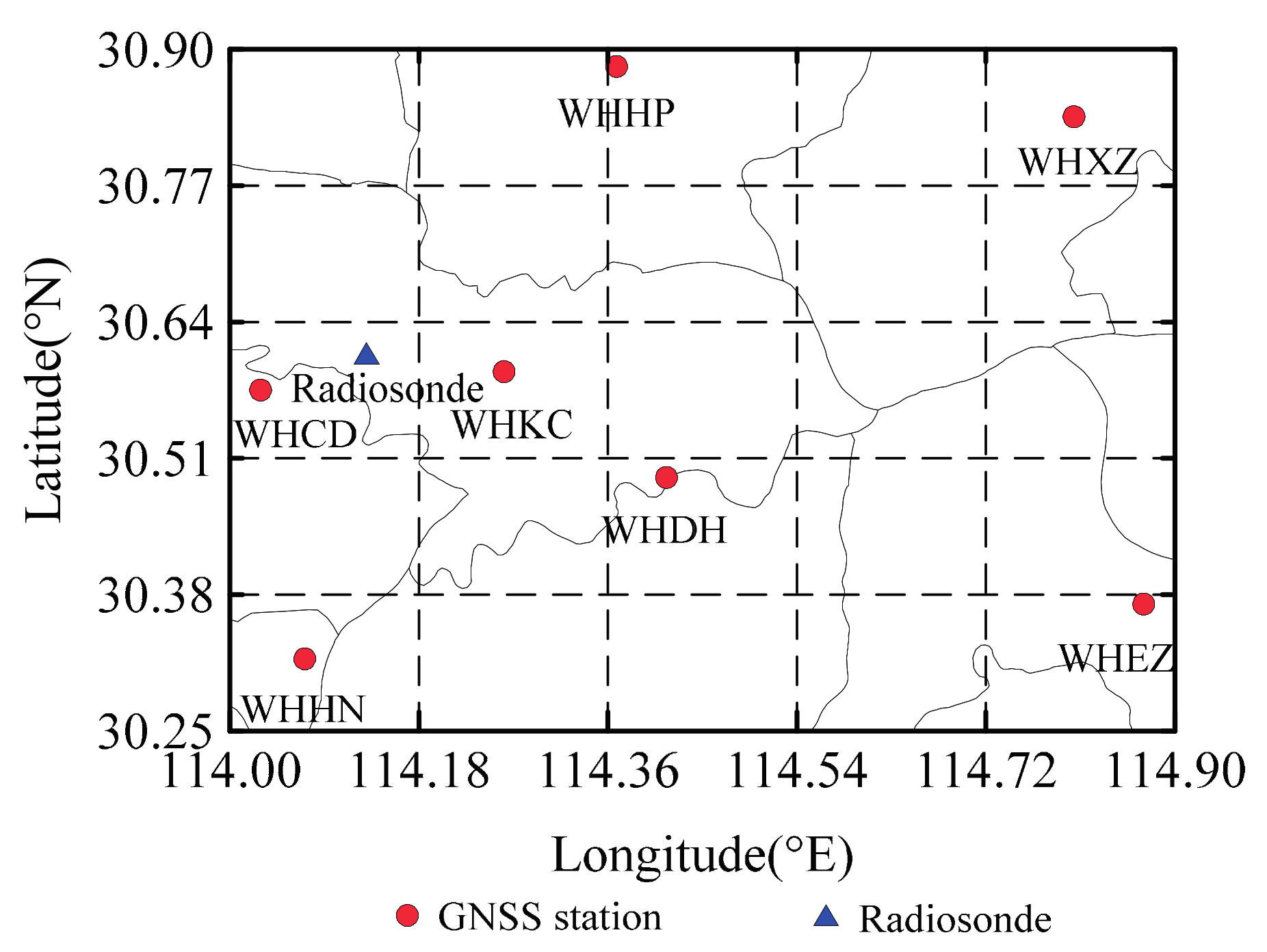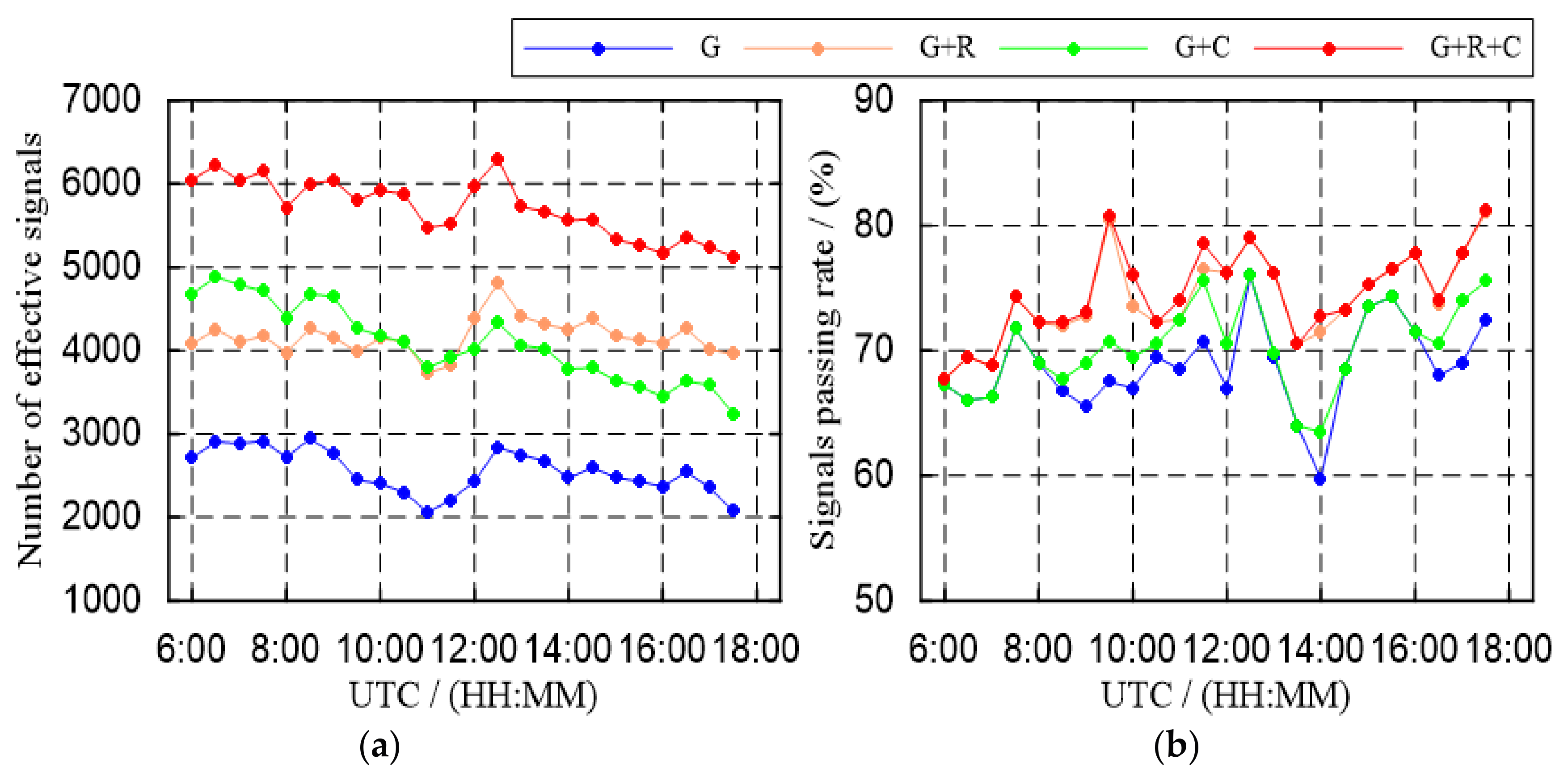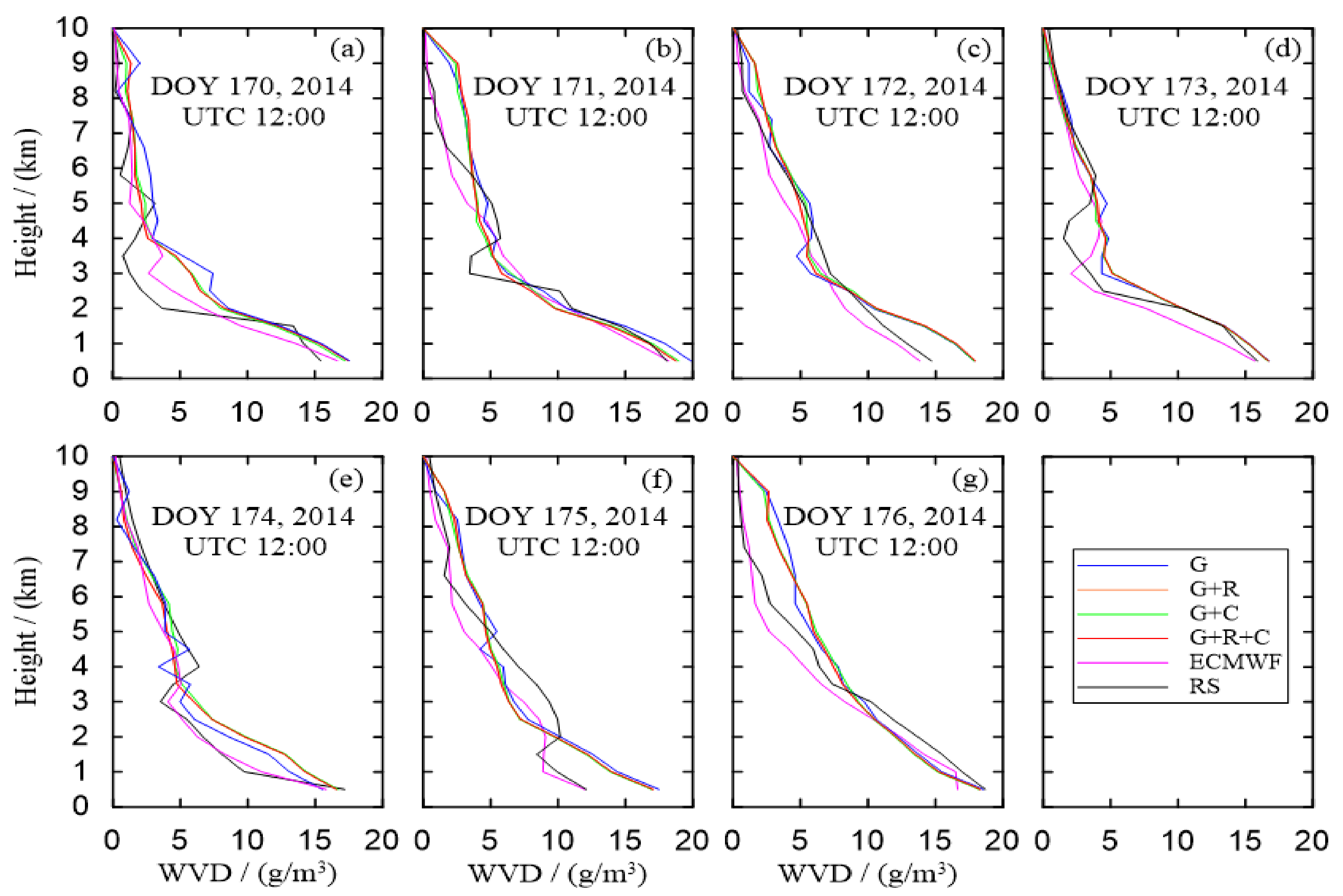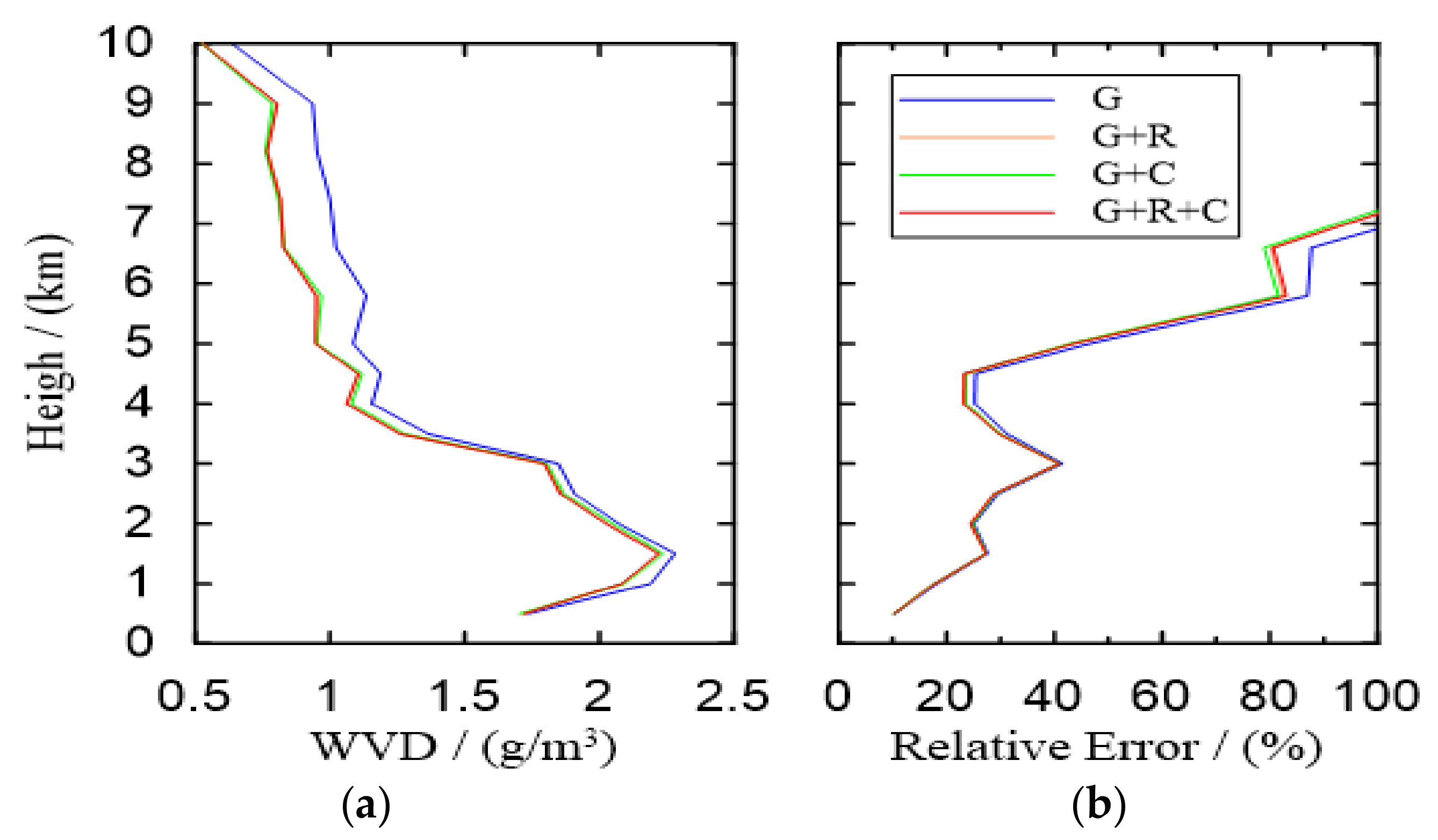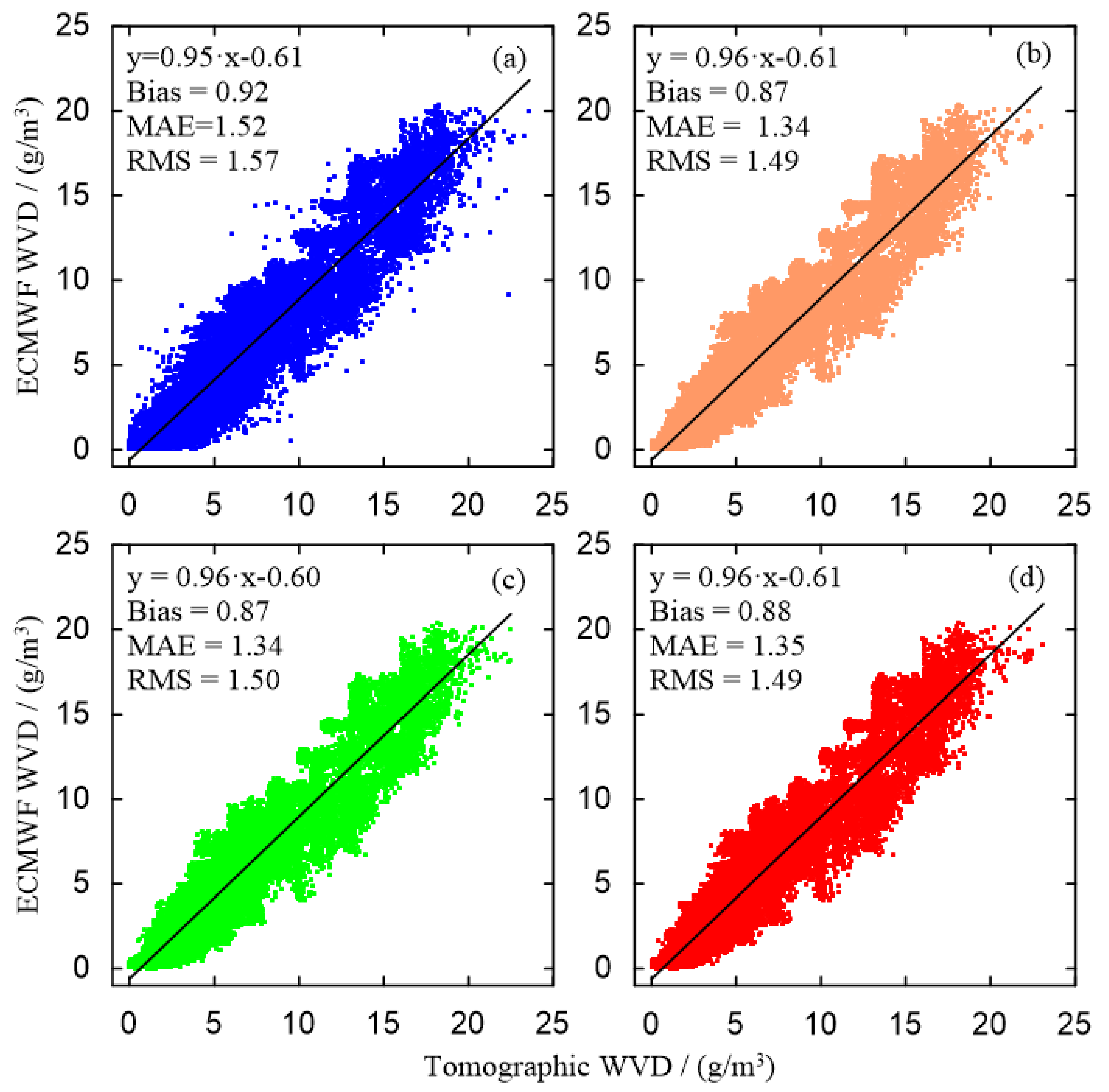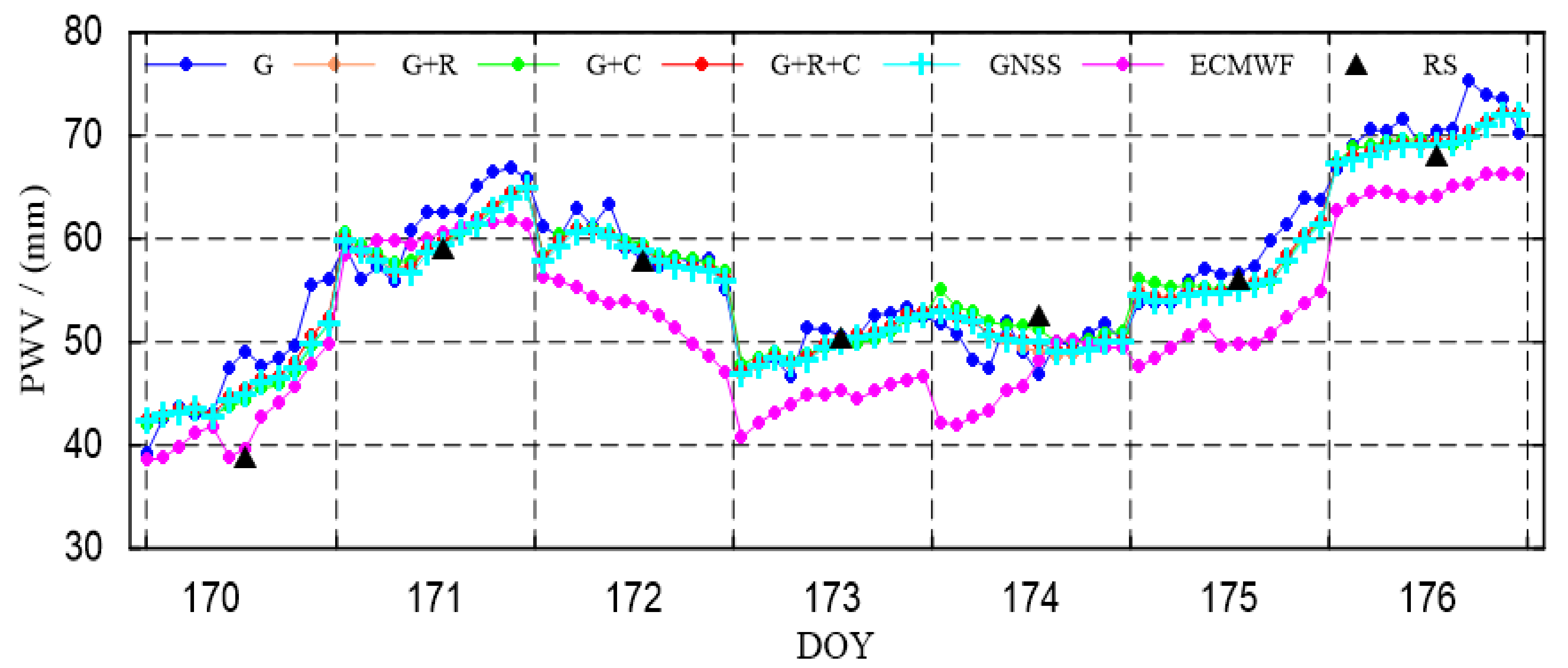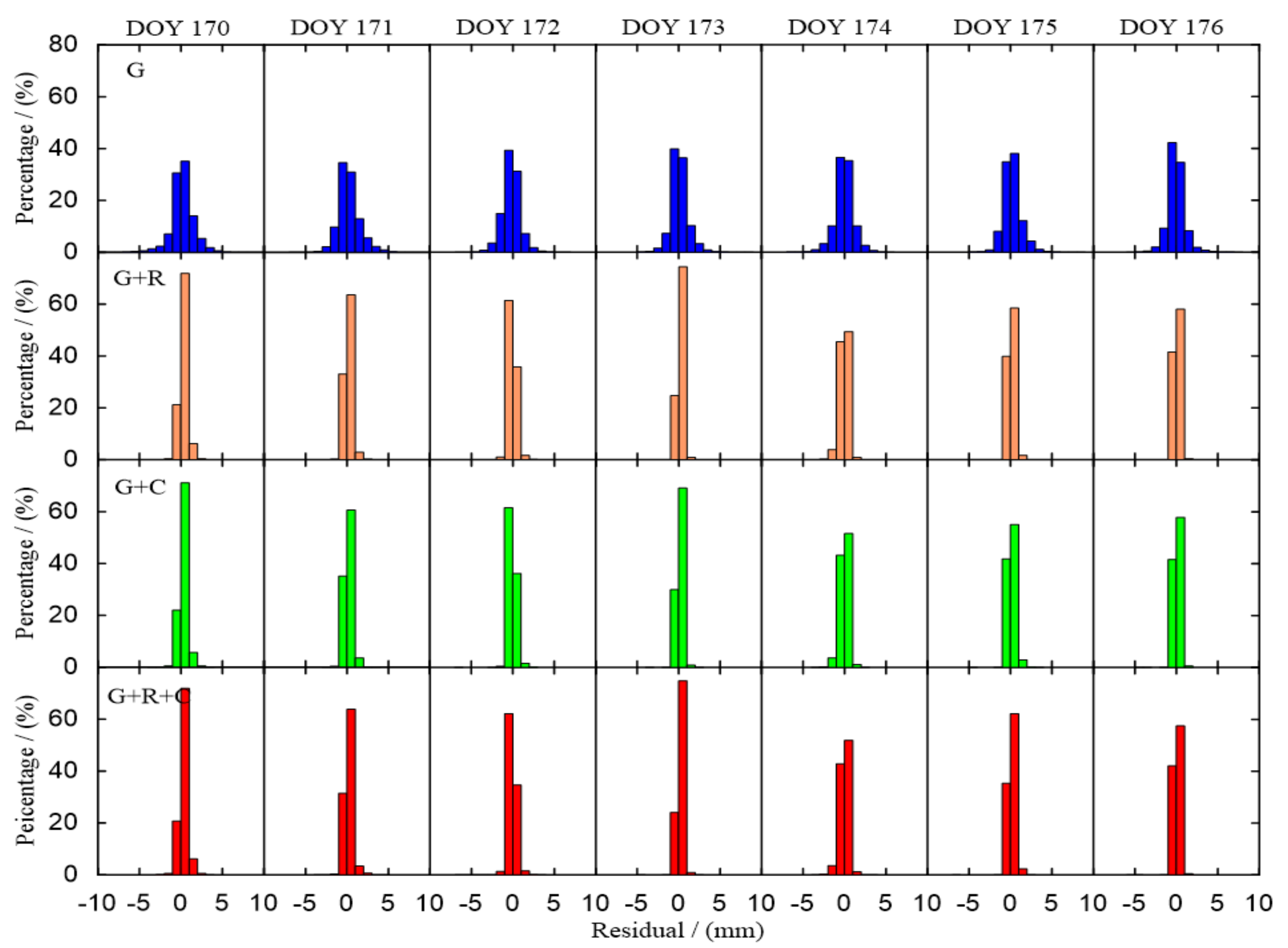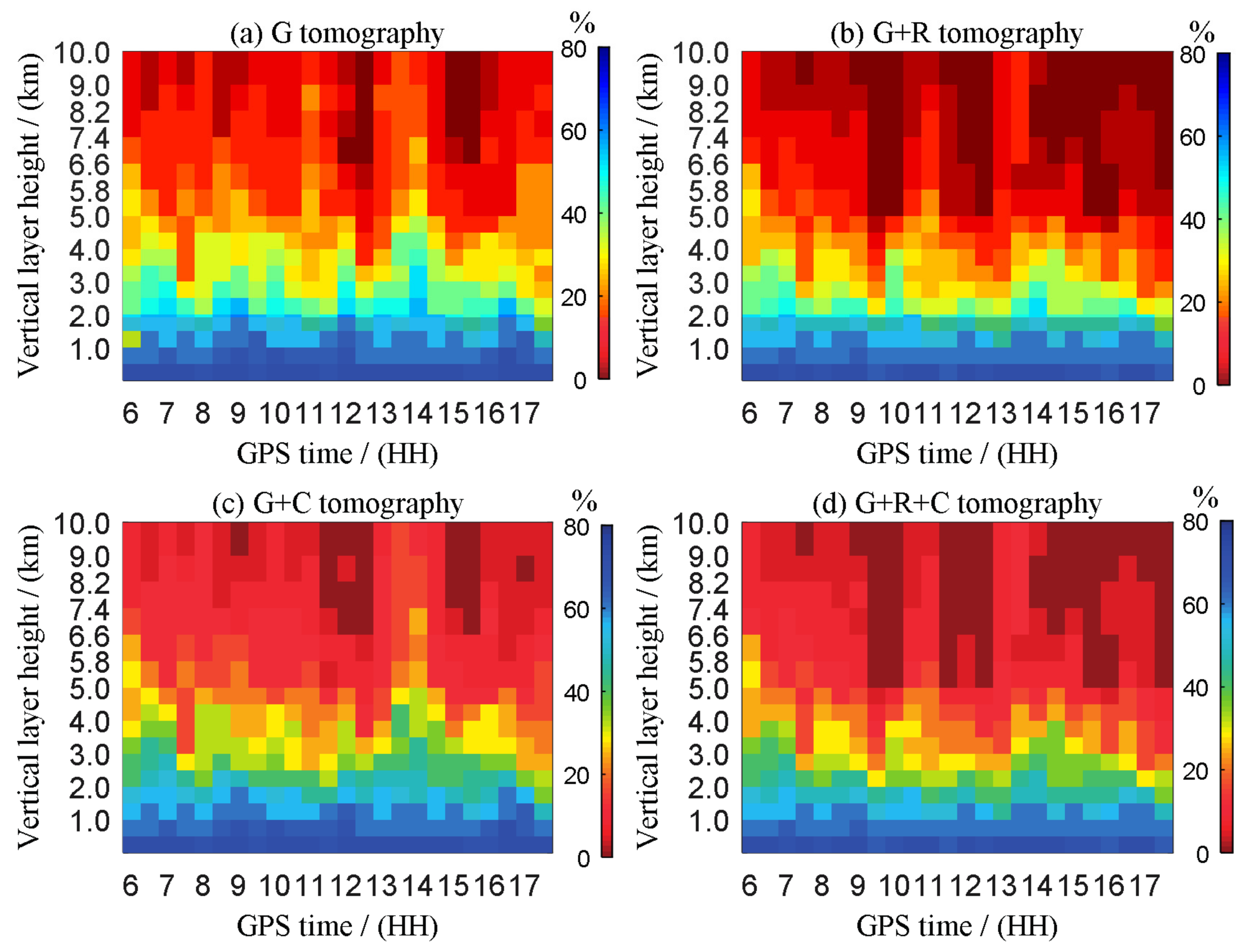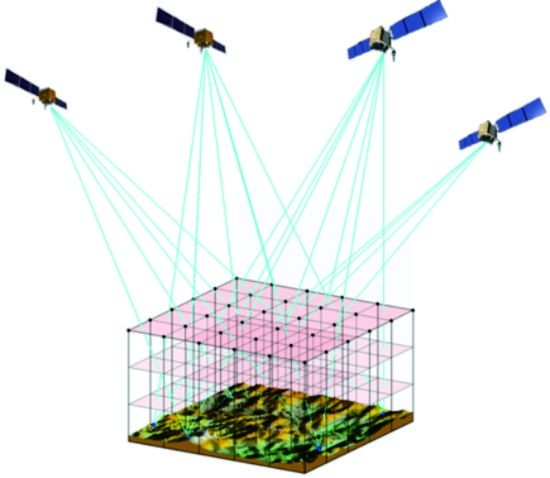2.1. GNSS Tropospheric Estimation
The tropospheric zenith total delay (
ZTD) can be obtained from GNSS observations, including the zenith hydrostatic delay (
ZHD) and zenith wet delay (
ZWD). The
ZHD can be precisely calculated by atmospheric models or surface meteorological parameters, and the zenith wet delay (
ZWD) can be obtained by subtracting
ZHD from
ZTD, namely:
There is a linear relationship between
ZWD and precipitable water vapor (
PWV) [
4]:
where
Π is the conversion factor between
ZWD and
PWV. The physical sense of
PWV represents the height at which water vapor in the atmosphere column of the unit bottom reaches saturation and condenses into liquid water.
Π is a function of the mean temperature of the water vapor
Tm:
where
ρw is the density of liquid water,
R is the universal gas constant (
R = 8314 Pa·m
3·K
−1·kmol
−1),
mw is the molar mass of water (
mw = 18.02 kg/kmol),
md represents the molar mass of the dry atmosphere (
md = 28.96 kg/kmol),
k1,
k2, and
k3 are empirical physical constants (
k1 = 77.604 K/hPa,
k2 = 70.4 K/hPa, k
3 = 3.776 × 10
5 K
2/hPa), and
Tm is related to the temperature and vapor pressure at different altitudes in the atmosphere. In practice, an empirical formula for surface temperature and
Tm is established by linear regression analysis using long-term radiosonde data [
1].
The observations of the tropospheric water vapor tomography are the integration of water vapor in the direction of the ray-path slant water vapor (SWV) which can be expressed as:
where
ρ(
l) represents the water vapor density,
dl specifies the length of a signal element,
Mw is the wet mapping coefficient, and the last term
R refers to the non-homogeneous variation of water vapor, which is calculated by multiplying the post-fit residual by the conversion factor.
2.2. Tomographic observation model
The principle of tomography technique is to use the integral observations to reconstruct the detailed information of the studied objects through a certain mathematical constraint. In GNSS meteorology, the integral observations of tropospheric tomography are SWV, with the movement of satellites in space and the rotation of Earth, and dense GNSS observations can retrieve the 3-D water vapor over the interested area with the tomography technique.
To solve the integral problem of total water vapor, the discretized method is adopted in GNSS water vapor tomography. Based on the voxel-based method, the tropospheric zone over the interested area is discretized into the self-enclosed 3-D voxels in horizontal and vertical directions (
Figure 1). Due to the limited number of ground stations, the total number of tomographic signals at single epoch is not enough and, therefore, it usually requires accumulating observation signals for a period time, which is called tomography window, so the inversion field is the average of the water vapor distribution over this period time. Assumed that the water vapor parameters of each voxel at epoch
t are represented by
X(
r, t), where
r stands for the position of voxels, the slant water vapor (
SWV) for signal
p in a single tomography window can be described as:
where
dl represents the intercept of the signal
p at the
r voxel.
Although we assumed that the water vapor status remains stationary in a tomography window and the number of accumulated tomography signals will be much larger than the total number of voxels, the tropospheric tomographic observation equations are still ill-posed as some voxels always have no signal passing due to the limited spatial distribution of satellites and stations on the ground network. Thus, the observation equations cannot be solved directly by the least square (LS) estimation. In order to solve the inversion problem of the singular design matrix in the tomography model, constraints are introduced into the observation model. It is supposed that there is a spatial correlation between the atmospheric water vapor in a specific voxel and surrounding voxels. The common methods of constraints include the horizontal constraint, vertical constraint, and boundary constraint [
6,
17].
In the same layer of the grid, it is assumed that there is a Gaussian inverse distance weighted relationship between the water vapor density of a voxel and the other voxels. The Gaussian distance weighting function has the following form:
where (
i,
j) represents the voxel location calculated at a certain layer of the grid, (
i1,
j1) stands for a nearby voxel,
di1, j1 represents the distance from voxel (
i,
j) to (
i1,
j1),
nl and
nn are the number of the grid divided in the latitude and longitude directions, and
δ is a Gaussian smoothing factor, which is determined according to the range of smoothing assumptions.
A priori water vapor distribution information is used to establish the vertical constraints [
13,
18] to solve the alteration phenomenon of inversion water vapor field that upper water vapor density is smaller than water vapor density at the bottom. In addition, the top boundary constraint can also be added to force the water vapor density of voxels at the topper layer to zeros. Then, the tomography model can be described as:
where
y is a column vector composed of all GNSS
SWV in a single tomography window,
AGNSS is the design matrix composed of GNSS signal intercepts at each voxel,
H,
V, and
B are the coefficient matrices for the horizontal, vertical, and top boundary constraints,
r represents the prior water density provided by external observation techniques, and
ε is the residual.
The design matrix of tomography equation established by GNSS technique and constraint equations is a large-scale sparse matrix and, in fact, the tomography solution is the inverse problem of the coefficient matrix. In order to ensure the physical sense of the solution, the results of the equations must be positive. The solving methods of tomography equations include the non-iterative algorithm, iterative algorithm and the joint approach of both. Non-iterative methods, such as LS, singular value decomposition (SVD), etc., are not sensitive to initial values, and only approximate values can be obtained. The iterative reconstruction method requires a higher precision initial value to converge, and the accuracy of the corresponding solution is also higher. Bender et al. [
19] compared different iterative reconstruction algorithms, and the results showed that the multiplicative algebraic reconstruction technique (MART) has better iterative accuracy and iterative speed. The MART algorithm is given by the following expression [
20,
21]:
where
swvi and
Ai represent the
ith observation of the GNSS tomography equations and the corresponding vector of equation coefficients, the inner product
is the back projection of
ith GNSS tomography observation after the
kth iteration, and
λ is the relaxation parameter, which gives the weight correction rate. MART algorithm can be divided into two steps, firstly, the water vapor density of voxels (index
j,
j = 1, 2, …, m) is corrected one by one for each observation (index
i,
i = 1, 2, …, n), and then the next iteration is performed (index
k,
k = 1, 2, …, p) until the solution converges. Balancing the advantages and disadvantages of non-iterative and iterative approaches, a combined method has been demonstrated [
22]. In this paper, the combined method is adopted, and SVD is implemented to obtain the approximate solution as the initial value of MART.
